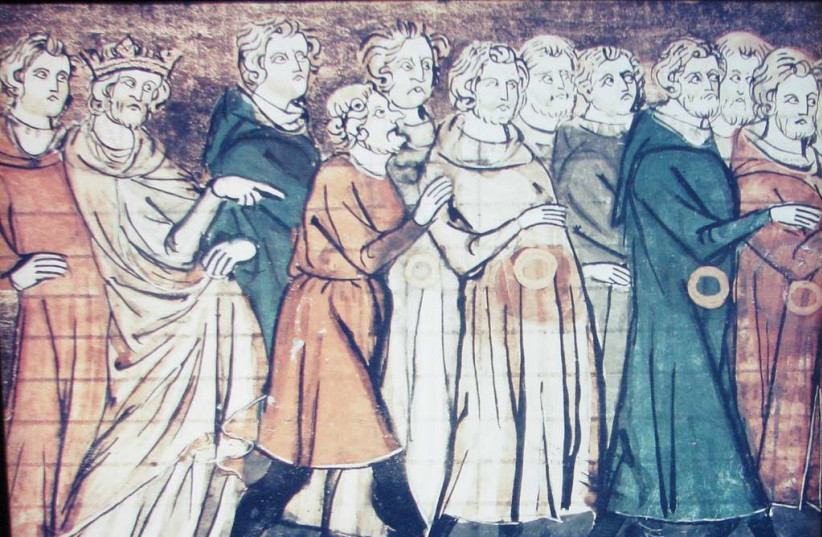In June 1753, King George II gave his royal assent to an act passed by the British Parliament. Known formally as The Jewish Naturalization Act, and informally as the Jew Law, it allowed foreign-born Jews applying for naturalization to omit the words “upon the true faith of a Christian” when taking the necessary oaths of loyalty,.
The ill-chosen title of the act was a chink through which opponents of the government, exploiting the invented fear that the door was being opened to a wholesale influx of foreign Jews, were able to mount a sustained political attack. With an eye on the forthcoming general election, a virulent antisemitic campaign was mounted demanding the repeal of the act.
Playing upon popular anti-Jewish prejudice, the opposition raised the political temperature to boiling point. Finally the government succumbed, and in December 1753 the act was repealed. Politically, it was a wise move. In the general election of 1754, the government was returned to power with a working majority.
In his new book, Antisemitism and the 1753 Jew Law Controversy, author Yoel Sheridan, born and educated in Britain, analyzes the ancient and long-enduring phenomenon of antisemitism in England. Essentially what he demonstrates is an abiding antisemitic element within English society, ever ready to boil over into violence in earlier times, and later into hate speech and discrimination. Since antisemitism is essentially irrational, he demonstrates that the trigger for antisemitic action at any one time can vary with the religious, social, or political weather.
The history of antisemitism in England
In his Introduction, Sheridan lists the series of antisemitic blood libels and pogroms against the first Jews who arrived in England, invited over by William I following his conquest of the country in 1066. The ever-present mindless hatred culminated in the expulsion of all Jews by the impoverished King Edward I in 1290. In return, incidentally, Parliament granted him the largest single tax raised in the Middle Ages.
England remained nominally Judenfrei for the next 366 years, though some Jewish merchants and physicians began trickling back from about 1492, when Jews were expelled from Spain. Shakespeare probably based his Shylock on meeting Jews from the families living in secret in England in the late 16th century.
In 1653, Oliver Cromwell, having masterminded the execution of King Charles I, had established a republic and assumed the title Lord Protector. Two years later, “despite objections,” as Sheridan puts it, “Cromwell tacitly allowed Jews to resettle in England.”
Sheridan describes the century between the readmission of the Jews and the Jew Act of 1753 as a period during which English national identity was in the process of development, “and,” he writes, “for many, a Church of England-Protestant-Christian identity was an essential part of having an English identity.” Religious zeal explains the ferocity of some of those objecting, misguidedly, to the Jew Act on the assumption that it was opening the door to the unlimited immigration of foreign Jews.
Sheridan quotes widely from pamphlets and other sources written by violent opponents of the act, as well as from some of those promoting it. A surprising revelation is the part played by George II in supporting the passage of the act and, after its repeal, how he was constrained by the widespread antisemitic sentiment from honoring the prominent Jew Gideon Samson with a baronetcy. In fact, George II had a close relationship with the Jewish community. In return, individually and through the British Board of Deputies founded in 1702, English Jews demonstrated great loyalty to him.
Sheridan makes the point that the antisemitic arguments deployed during the Jew Law controversy, unconstrained as they were by today’s anti-race and anti-hate laws, reveal its true nature. Antisemites believe that Jews live within any society under sufferance and can always have their rights curtailed, for whatever reason may be convincing at the time. He maintains that the danger of antisemitism extends beyond the Jews who are its target. It “poisons the well of decent society,” he says.
Antisemitism and the 1753 Jew Law Controversy is a most valuable and timely book, especially given the recent demonstration of rampant Jew-hatred by Hamas. To anyone intent on fighting this most ancient of prejudices, Sheridan’s scrutiny and analysis of antisemitism in England, and in particular the events surrounding the Jew Law of 1753, provide essential background and understanding. One vital lesson is that interests hostile to democracy can readily use antisemitism as a weapon to advance their private agendas. This was the case in the England of 1753, as it was in the Germany of 1933. What was true before may well be true now and in the future.
Sheridan has provided a truly significant aid to understanding the nature of antisemitism. It undoubtedly deserves to be read, indeed studied.■
- Antisemitism and the 1753 Jew Law Controversy
- Yoel Sheridan
- Austin Macauley Publishers Limited, 2022
- 102 pages; $8.95

